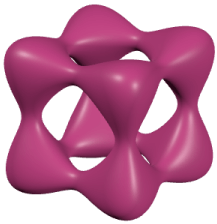Graphing Linear Equations¶
$$ \require{color} \definecolor{brightblue}{rgb}{.267, .298, .812} \definecolor{darkblue}{rgb}{0.0, 0.0, 1.0} \definecolor{palepink}{rgb}{1, .73, .8} \definecolor{softmagenta}{rgb}{.99,.34,.86} \definecolor{blueviolet}{rgb}{.537,.192,.937} \definecolor{jonquil}{rgb}{.949,.792,.098} \definecolor{shockingpink}{rgb}{1, 0, .741} \definecolor{royalblue}{rgb}{0, .341, .914} \definecolor{alien}{rgb}{.529,.914,.067} \definecolor{crimson}{rgb}{1, .094, .271} \definecolor{indigo}{rgb}{.8, 0, .6} \def\ihat{\hat{\mmlToken{mi}[mathvariant="bold"]{ı}}} \def\jhat{\hat{\mmlToken{mi}[mathvariant="bold"]{ȷ}}} \def\khat{\hat{\mathrm{k}}} \def\tombstone{\unicode{x220E}} \def\contradiction{\unicode{x2A33}} \def\textregistered{^{\unicode{xAE}}} $$
You can represent a system of two linear equations in two variables $x$ and $y$ geometrically as two lines in the plane. These lines can intersect at a point, coincide, or be parallel as in the Figure 1.
1.¶
Consider the system below, where $a$ and $b$ are constants
$$ \begin{align*} 3x -\ y &= 3 \\ ax + by &= 6 \end{align*} $$
(a) Find values for $a$ and $b$ for which the resulting system has a unique solution. Show that the solution is unique. Determine the solution.
(b) Find values for $a$ and $b$ for which the resulting system has infinitely many solutions. Show that linear system has infinitely many solutions. Determine the solution set.
(c) Find values for $a$ and $b$ for which the resulting system has no solution. Show that the linear system has no solution.
(d) Graph the lines for each of the linear systems in parts (a), (b), and (c) on separate graphs. Include your graphs on the same page with your answers to (a)-(c). Do not create your plots with pen and paper. You must create your plots using your favorite graphing software. I suggest MATLAB$\textregistered$,
GeoGebra$\textregistered$, or
 Desmos$\textregistered$.
Desmos$\textregistered$.
2.¶
Consider a linear system with three linear equations in $x$, $y$, and $z$. The graph of each linear equation is a plane in a 3-dimensional coordinate system.
(a) Find an example of such a linear system whose graph is given by Figure 2. All three planes intersect in a single line. Thus there are infinitely many solutions to the linear system; all of the points on the common line.
(b) Find an example of such a linear system whose graph is given by Figure 3. The three planes intersect at a single point. Thus the linear system has exactly one solution; the point that lies on all three planes.
(c) Find an example of such a linear system whose graph is given by Figure 4. Two of the planes are parallel and do not intersect. Yet the third plane is not parallel so it intersects eachh of the first two planes in a line. The resulting intersections form a pair of parallel lines. Thus there are no solutions to the linear system because there are no points on all three planes.
(d) Are there other ways in which three planes can intersect to obtain distinct kinds of graphs; each with their own solution set. Create graphs of the other possible graphs of three equations with three unknowns in 3-dimensional space and include your graphs in your pdf with your responses. Do not create your plots with pen and paper. You must create your plots using your favorite graphing software. I suggest MATLAB$\textregistered$,
GeoGebra$\textregistered$, or
 Desmos$\textregistered$.
Desmos$\textregistered$.
